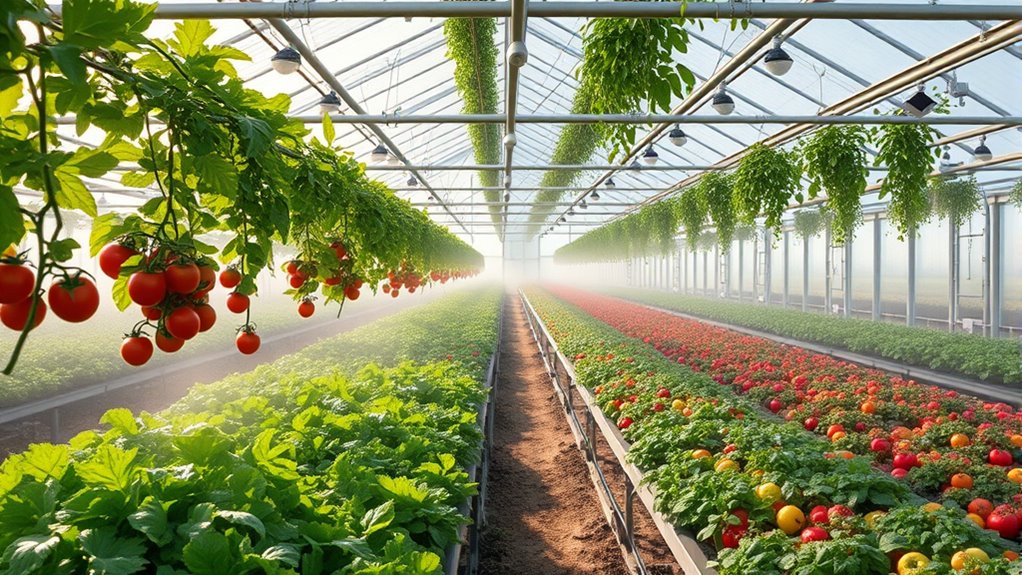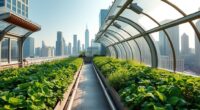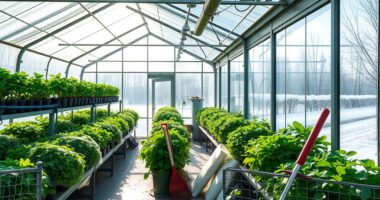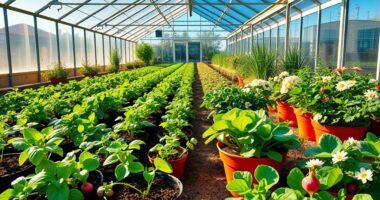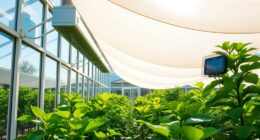To plan your greenhouse crops for a continuous harvest year-round, you should use season extension techniques like supplemental lighting, row covers, and heat-retaining structures. Rotate crops regularly to prevent soil depletion and pests, grouping them by family for healthier plants. Map out your planting schedule for early spring, summer, fall, and winter, incorporating protected growth methods. To maximize your greenhouse’s potential all year, implementing these strategies will set you on the right path—discover more tips below.
Key Takeaways
- Map crops to specific seasons and use season extension techniques to enable year-round growth.
- Implement crop rotation to maintain soil health and prevent pest buildup throughout the year.
- Start seedlings early and transplant into the greenhouse for continuous harvest cycles.
- Use supplemental lighting and heat-retaining structures to extend growing conditions into off-seasons.
- Plan a diverse planting schedule to maximize greenhouse space and ensure a steady supply of fresh produce.
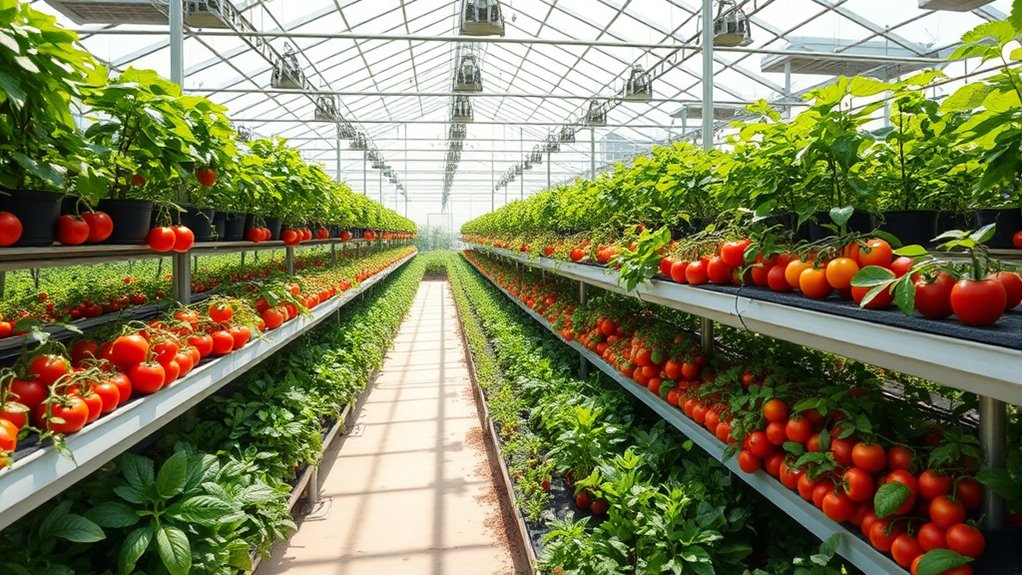
Planning your greenhouse crops effectively is essential for a successful growing season. When you focus on season extension, you can maximize your harvests and make the most of your space throughout the year. Implementing techniques such as using heat-retaining structures, supplemental lighting, and row covers allows you to start earlier in the spring and continue growing later into the fall and winter. These methods help you maintain ideal growing conditions despite outside weather fluctuations, giving you a longer window to grow a variety of crops. By extending the season, you reduce downtime and can produce fresh vegetables, herbs, and flowers year-round, increasing both your yield and your enjoyment of gardening.
Extending your growing season boosts yields and enjoyment year-round.
Equally important is planning your crop rotation carefully. When you rotate crops, you prevent soil depletion and reduce the buildup of pests and diseases that can harm your plants. For example, you might plant leafy greens after root vegetables or legumes following heavy feeders like tomatoes. This practice keeps your soil healthier and ensures that each crop has the nutrients it needs to thrive. Crop rotation also helps break pest and disease cycles, which are often specific to certain plant families. If you continually plant the same crops in the same spots, you risk increasing pest populations and soil-borne diseases, which can drastically reduce your harvests. Rotating your crops not only promotes healthier plants but also improves overall soil fertility, reducing the need for chemical inputs.
In your planning process, consider how different crops fit into your year-round schedule. Map out which plants are best suited for early spring, summer, fall, or winter, and plan your planting calendar accordingly. Incorporate season extension techniques to start seedlings early indoors or in protected environments, then transplant them into your greenhouse once conditions are suitable. As one crop finishes, prepare the space for the next by rotating different plant families into that spot. This continuous cycle keeps your greenhouse productive and prevents soil fatigue.
Additionally, pay attention to the specific needs of each crop, like light, temperature, and humidity, to maximize growth. Combining season extension with strategic crop rotation not only boosts your productivity but also enhances the sustainability of your greenhouse operation. With thoughtful planning, you can enjoy a steady supply of fresh produce all year long, making your greenhouse a reliable source of fresh food, regardless of outside weather.
Frequently Asked Questions
How Can I Extend the Growing Season in My Greenhouse?
To extend your growing season, you can implement season extension techniques like installing thermal curtains, heaters, or shade cloths to regulate temperature. Practice crop rotation to keep soil healthy and prevent disease buildup. These strategies help you maximize your greenhouse’s productivity, allowing you to grow crops year-round. By adjusting environmental controls and rotating crops, you’ll enjoy a continuous harvest and make the most of your greenhouse space.
What Are the Best Crops for Year-Round Greenhouse Cultivation?
You should focus on crop selection that thrives year-round, like leafy greens, herbs, and certain vegetables. Incorporate crop rotation to prevent soil depletion and reduce pests. By choosing hardy varieties and rotating crops regularly, you can guarantee a steady harvest. This approach helps maintain soil health, boosts yields, and keeps your greenhouse productive throughout the year. Stay flexible and adapt your crop choices based on season and growth success.
How Do I Manage Pests and Diseases Year-Round?
Think of pest prevention and disease management as your greenhouse’s immune system. You should regularly monitor plants for signs of trouble, keep everything clean, and guarantee proper airflow. Use integrated pest management strategies, like beneficial insects and organic repellents, to keep pests at bay. Quarantine new plants and sanitize tools to prevent disease spread. Staying vigilant year-round helps you catch issues early and keeps your crops healthy and thriving.
What Temperature and Humidity Levels Optimize Continuous Harvests?
You should aim for climate control that maintains temperatures between 65-75°F and humidity levels around 60-70% to optimize continuous harvests. Proper environmental regulation guarantees plants grow steadily without stress, reducing pests and diseases. Use heaters, fans, and humidifiers to fine-tune conditions. Consistent monitoring helps you adjust settings promptly, creating ideal conditions that promote healthy, continuous crop production and maximize your greenhouse yield.
How Can I Maximize Space for Diverse Crops?
Think outside the box to maximize your space; vertical farming is your secret weapon for diverse crops. Use stacking systems and tiered shelving to create multiple layers, effectively turning your greenhouse into a bustling city of plants. Incorporate crop rotation to keep soil healthy and pests at bay. This way, you optimize every inch, ensuring a continuous harvest while making your greenhouse a thriving, multi-dimensional oasis.
Conclusion
By planning carefully, choosing the right crops, and managing your greenhouse diligently, you can enjoy a continuous harvest year-round. Consistent effort leads to steady yields, thoughtful scheduling ensures variety and freshness, and proactive adjustments keep your crops thriving. With dedication, your greenhouse becomes a reliable source of fresh produce, a place of growth and abundance. Embrace the process, stay committed, and watch your garden flourish, providing you with fresh, healthy food every season of the year.
